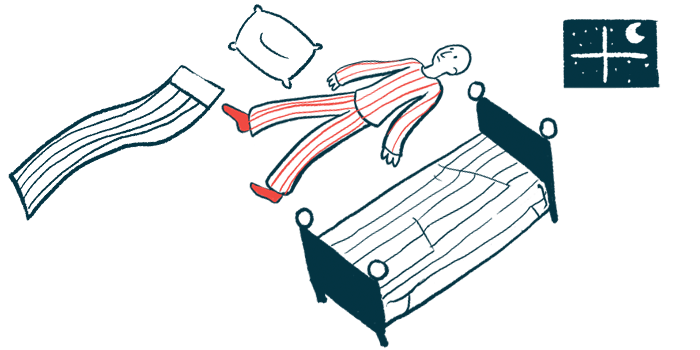Sleep Disorder Tied to Faster Disease Progression

Early Parkinson’s patients with rapid eye movement sleep behavior disorder (RBD) have more severe symptoms and show a faster disease progression in terms of motor, mood, and cognitive symptoms, according to a U.K. study.
Moreover, these patients had a higher risk of frequent falls, freezing of gait — when they feel as if their feet are “glued” to the floor and can’t move forward — and mild cognitive impairment, compared with patients without RBD.
These findings highlight the importance of screening for RBD symptoms to help anticipate disease progression trajectories, provide better individualized treatment, and identify patients who may benefit from earlier-targeted motor interventions, the researchers noted.
The study, “Longitudinal Changes in Parkinson’s Disease Symptoms with and Without Rapid Eye Movement Sleep Behavior Disorder: The Oxford Discovery Cohort Study,” was published in the journal Movement Disorders.
Besides its well-known motor symptoms, Parkinson’s disease is characterized by non-motor symptoms, such as cognitive impairment, sleep disturbances, and depression.
RBD, a sleep condition in which a person physically reacts to events happening in a dream, affects up to 42% of Parkinson’s patients and has been studied increasingly as a potential early marker of the disease.
Previous research also has suggested that RBD is associated with “a higher burden of non-motor symptoms, as well as more severe motor disease,” but whether its presence in early Parkinson’s influences the progression rate of other symptoms remains largely unclear, the researchers added.
To address this, a team of researchers at the University of Oxford, in the U.K., evaluated RBD’s impact on the progression of motor and non-motor symptoms over time in 923 people with early Parkinson’s.
Patients had been diagnosed within the past 3.5 years, and were recruited from 2010 to 2019 to join the Oxford Parkinson’s Disease Centre Discovery cohort, an ongoing study of early Parkinson’s involving 11 hospitals.
Participants’ demographic and clinical features, including motor and non-motor symptoms, were assessed every 18 months through standard questionnaires and measures. Given that RBD’s rates were shown previously to increase over time among Parkinson’s patients, its potential presence was determined over time, based on RBD Screening Questionnaire scores.
Patients’ mean age was 67.1 years, and most were men (64.1%), married (78.2%), and white (94.8%). A total of 788 (85.4%) participants completed at least one follow-up visit — with a mean of 4.8 years of follow-up and up to 8.3 years — and 153 completed all visits.
Reasons for limited follow-up data included severe illness that prevented such assessments, study withdrawal or loss to follow-up, and death.
Results showed that 307 patients (33.3%) had possible RBD either at study’s start or during follow-up. These patients were significantly more likely to be men and to receive higher levodopa-equivalent daily doses than those without signs of RBD.
The presence of RBD was not associated significantly with the use of dopamine agonists.
Compared with patients without RBD, those with the sleep disorder had more severe symptoms at study’s start (baseline), including worse overall motor skills, posture, balance, walking difficulties, sleep problems, depression, anxiety, and cognitive function.
RBD-positive patients also showed faster progression on overall non-motor and motor symptoms, and in hand dexterity problems, depression, and cognitive impairment. They also had a significantly higher risk of frequent falls, freezing of gait, and mild cognitive impairment, compared with patients without RBD.
The results were obtained after adjusting for potential influencing factors, such as age, sex, and levodopa-equivalent daily doses at baseline.
These findings highlight that Parkinson’s patients with RBD “progress faster on motor, mood, and cognitive symptoms, confirming a more aggressive [Parkinson’s] subtype that can be identified at baseline and has major clinical implications,” the researchers wrote.
The data are consistent with previous research suggesting that RBD is associated with faster Parkinson’s progression, further supporting RBD as a “key marker of faster progression in a wide range of symptom domains,” the team wrote.
As such, “screening for RBD symptoms at the time of Parkinson’s diagnosis could improve estimation of subsequent disease trajectory, enabling better individualized treatment, information, and support to be offered to patients and their caregivers,” they added.
Given that RBD “is associated with higher rates of levodopa-unresponsive symptoms, including cognitive impairment, [postural instability and walking difficulties], gait freezing, and falls,” this subgroup of patients may “benefit from earlier-targeted interventions, including proactive exercise, physiotherapy, occupational therapy, and bone health management,” the researchers wrote.
Among the study’s limitations, the team emphasized the lack of RBD’s confirmation through polysomnography, the gold standard for assessing sleep disorders, which would have provided a more accurate representation of the condition and reduced potential misclassification.







